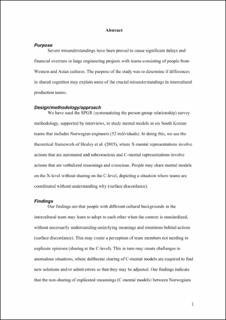| dc.description.abstract | Purpose
Severe misunderstandings have been proved to cause significant delays and financial overruns in large engineering projects with teams consisting of people from Western and Asian cultures. The purpose of this study was to determine if differences in shared cognition may explain some of the crucial misunderstandings in intercultural production teams.
Design/methodology/approach
The study has used systematizing the person–group relationship (SPGR) survey methodology, supported by interviews, to study mental models in six South Korean teams that also includes Norwegian engineers (52 individuals). In so doing, the study uses the theoretical framework of Healey et al. (2015), where X-mental representations involve actions that are automated and subconscious and C-mental representations involve actions that are verbalized reasonings and conscious. People may share mental models on the X-level without sharing on the C-level, depicting a situation where teams are coordinated without understanding why (surface discordance).
Findings
The findings of the study are that people with different cultural backgrounds in an intercultural team may learn to adapt to each other when the context is standardized, without necessarily understanding underlying meanings and intentions behind actions (surface discordance). This may create a perception about team members not needing to explicate opinions (sharing at the C-level). This in turn may create challenges in anomalous situations, where deliberate sharing of C-mental models is required to find new solutions and/or admit errors so that they may be adjusted. The findings indicate that the non-sharing of explicated reasonings (C-mental models) between Norwegians and Koreans contributed in sharing C-mental models, despite having an implicit agreement on how to perform standard tasks (sharing X-mental models).
Research limitations/implications
The study is limited to Norwegians and Koreans working in production teams. Future studies could benefit from more cultures and/or different team contexts. The authors’ believe that the findings may also concern other standardized environments and corroborate previous perspectives on intercultural teams needing to both train (develop similar X-mental representations) and reflect together (develop similar C-mental representations).
Practical implications
Based on our findings we suggest the using of cross-cultural training at a deeper level than previously suggested, training in both social interaction patterns as well as verbalizing logical reasoning together. This entails reaching a shared and joint understanding of not only actions but also values, feelings and teamwork functions. This can be enabled by group conversations and training in dynamic team patterns. Important is, however, that standardized contexts may dampen the perception of the need to do both.
Originality/value
The study contributes to current research on intercultural teams by focusing on a dual-mode perspective on shared cognition, relating these to contextual factors. In this, the authors’ answer the call in previous research for more information on contextual matters and a focus on interaction in intercultural teams. The study also shows how the differences between X-mental and C-mental shared mental models play out in a practical setting. | en_US |
